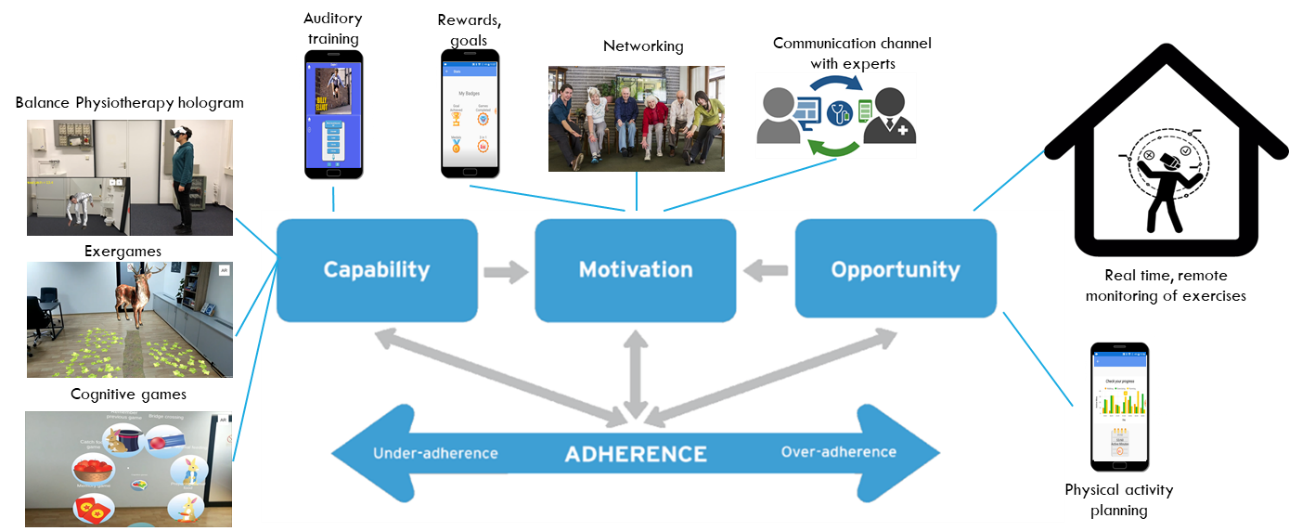Holobalance Project Update
Published on 28 October 2019 11:30 AM
Age UK London is delighted to be a partner in Holobalance - an EU-funded transnational programme taking place over a three year period (Dec 2017 - Nov 2020).
The overall objective of Holobalance is to develop a new personalized holographic platform to virtually coach older people with balance disorders.
The following is an update from the Holobalance team:
Holobalance: HOLOgrams for personalised virtual coaching and motivation in an ageing population with BALANCE disorders
A New Patient Experience:
One third of the general population will experience vertigo and dizziness at least once in their lifetime. Dizziness is a very common ailment for those over the age of 65 and can massively increase the chances of a fall, particularly for those with existing balance disorders. Falls are one of the leading causes of serious injury and death for older citizens, with 50% of accidental deaths in this age group resulting from falls. It is estimated that the annual direct and indirect cost of falls-related injuries will reach $ 67.7 billion by 2020 [1].
Thankfully, early personalised treatment can reduce the likelihood of falling and can eventually prevent falls from occurring. In particular, Vestibular Rehabilitation Therapy (VRT) [2] has been reported as effective for those suffering from vertigo and balance disorders [3], especially when provided through a personalized rehabilitation programme that is supervised by an expert physiotherapist. [4, 5].
Using funding from the European Union, the innovative Holobalance project is developing and evaluating a new platform that will provide 8-12 week balance rehabilitation plans, including:
- Personalized Vestibular Rehabilitation Therapy with guidance from holographic physiotherapists and augmented reality games
- Remote and automatic assessment of users' performance in daily sessions using sensors (IMUs, insoles with pressure sensors, depth camera)
- Mobile applications for auditory training and daily physical activity planning and monitoring (steps, active-sedentary periods)
The results are securely transmitted daily from the patient’s home to cloud services, so that physiotherapists can tailor their rehabilitation plan accordingly. The objective, in addition to improving symptoms and balance, is to motivate the patients and help them to manage their own recovery. The short-term goal is to increase compatibility with home-based rehabilitation platforms and the long-term aim is to achieve behavioral change and empower citizens to adopt a more active and healthy lifestyle.

Figure 1: Holobalance interventions to improve users' compliance with the rehabilitation plan.
The three-year Holobalance project is currently in the second year of its duration. The technical evaluation of the platform is nearing completion, which will allow the necessary refinements to be made ahead of the pilot launch. The pilot will see the system brought into the homes of 80 users in Athens, Freiburg, and London, so that the feasibility and effectiveness of Holobalance can be evaluated (in comparison to another 80 users receiving standard care).
The project involves 13 partners from across Europe and is coordinated by Prof. Dimitrios I. Fotiadis, who is Professor of Biomedical Engineering at the University of Ioannina.

If you would like more information about the project visit https://holobalance.eu/
References
1. CDC. Older Adult Falls - Costs of Falls Among Older Adults. Center for Disease Control and Prevention. Available at http://www.cdc.gov/homeandrecreationalsafety/falls/fallcost.html. 2015 21 Sep; Accessed: 2016 Mar 28.
2. S. L. Whitney, A. A. Alghwiri, and A. Alghadir, "An overview of vestibular rehabilitation," Handb Clin Neurol, vol. 137, pp. 187-205, 2016.
3. P. M. Dunlap, J. M. Holmberg, and S. L. Whitney, "Vestibular rehabilitation: advances in peripheral and central vestibular disorders," Curr Opin Neurol, vol. 32, no. 1, pp. 137-144, Feb 2019.
4. T. Szturm, D. J. Ireland, and M. Lessing-Turner, "Comparison of different exercise programs in the rehabilitation of patients with chronic peripheral vestibular dysfunction," J Vestib Res, vol. 4, no. 6, pp. 461-79, Nov-Dec 1994.
5. M. B. Badke, T. A. Shea, J. A. Miedaner, and C. R. Grove, "Outcomes after rehabilitation for adults with balance dysfunction," Arch Phys Med Rehabil, vol. 85, no. 2, pp. 227-33, Feb 2004.

